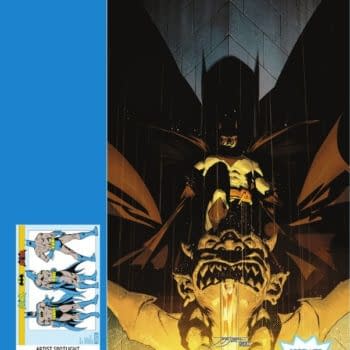Posted in: Comics, Recent Updates | Tagged: Comics, dc, Paul Levitz
Reading 75 Years Of DC Comics by Greg Baldino
Greg Baldino writes for Bleeding Cool
75 Years of DC Comics: The Art of Modern Myth Making is a difficult book to review here at the start of 2012– and not just because it weighs fifteen pounds and takes up almost as much space as a Torah scroll when open*. The past year has seen DC Comics change dramatically, both as a company and as a fictional universe, and with the shakeup of the relaunch both in continuity and in its publishing scheme, the book is almost an artifact of a parallel world.
Written by DC writer and former executive Paul Levitz and published in 2010, the massive tome is an overview of the company, from its initial founding as National Allied Periodicals by Major Wheeler-Nicholson up to the ascension of Geoff Johns. Taschen Books produced the volume as part of their line of oversized art books; each of it's 700+ pages is bigger than an open comic book, all the better to showcase the wealth of art on display. Levitz accompanies the plethora of imagery with a narrative history of DC's evolution as a publishing phenomenon.
Which truly DC was. We learn for example that back when it was National, they were the first publisher to expand stories beyond the one-or-two page format left over from the newspaper format that preceded the modern comic book. Looking back through the companies history, what's amazing is that for as often as DC has been viewed as a conservative player, they've actually been quite progressive in driving the American comic book industry forward, and have grown in their influence of the greater national culture. One of the ways the book illustrates this is with a series of large gatefold timelines which outline major events both in the wide world and DC Comics for each decade since the company's inception. (Which points out interesting collusions, such as the premiere of the Batman the Animated Series happening the same year as the advent of the web-browser, both of which would be instrumental through the decade in bringing in new readers from outside direct market stores. Hey, and nothing had to be relaunched to make that work. Go figure.)
More than just a history though, the book is a veritable multiverse of art, many of it never printed before and much of it never before printed so well. We get to see a number of the early Action Comics covers before Superman came to dominate them– and frankly some of those artists would have no trouble finding work right now for the quality of their illustrations. A number of titles from DC's experiments with non-superhero comics are represented, from Bat Lash to Binky (Who, Paul Levitz informs us, was the first DC character to launch in their own book instead of an anthology title.)
While Marvel is usually given credit for styling their covers as "pop art", this book shows that DC Comics have pushed innovation since their early years, and continued reinventing the idea of what a cover could do onward. The cover of Flash #110, showing a confrontation between the titular character and some artificially angered weather, is a post-modern fine-art mashup between the styles of Hokusai and Marinetti: the Flash's spinning arm evoking the action-lines of the Futurist school of art. Who says a cover has to just be a cover? Action Comics #360 uses an actual board game for it's cover. And of course who could forget the Flash staking his life on YOU? It becomes apparent reading this book that there's a thread that connects the art and style of DC throughout its three-quarters of a century and counting. It's not a house style per se, but more an approach that comics could do almost anything, even in its more aesthetically conservative periods.
But what is perhaps most invigorating about the book are the people, the mortal men and women who for more than half a century wrought dreams from ink and paper. One full page photograph shows artist Mike Sekowsky sketching the model Joyce Miller as she stands on a couch before a wall of comic covers. And sure he's just a comics artist and she's just an illustrator's model, but it's hard to not think that this is how it was with Botticelli, and Leonardo, and Toulouse-Lautrec; that through art, ordinary mortal people become extraordinary immortals through art. Olive Byrne, for instance, would be lost to the dustbin of time, had her romance with her professor and his wife not led to her being the visual inspiration for Wonder Woman. It's not just 75 Years of a publishing company, it's 75 Years of men and women creating ideas that were too brilliant, too strong, too fascinating to die. Whole fictional realities created and destroyed, sometimes in less than a page. Mild mannered common folk who opened up their heads and hearts to spend a century reinvent fiction for the next millennium.
There was nothing like DC Comics before. No precedent. All the measuring sticks that came after it were still in one way or another cut from the same cosmic world tree that was born trying to make a fast buck on the mean streets of 1930s New York City.
Which makes it just a little uncomfortable to see in the new DC Comics things like the notation that Green Lantern's first appearance was in Justice League #1 in the year 2011. It's a marketing ploy that doesn't even make much of an effort at not sounding Orwellian. For all the possibilities that have been opened up, the good ones and the bad ones, there's a sad sense that the main marketing thrust of the new DC is "Our history, our rich and crazy history, is a burden. Pretend we were born yesterday."
And yet, none of it is truly lost. Those thousands of comics still existed, can still be found. The histories, oral and written, can still be accessed, as in books like 75 Years and from those veterans still with us like author Paul Levitz. Another way to take the relaunch– and a way that fits smoothly into the whims and ways of DC's history– is "All those imaginary stories? Pretend they were dreams and hoaxes."
It has been pointed out– in a DC comic, no less– that all stories are imaginary.
But not the incredible, impossible stories in 75 Years. You can't make stuff like that up.
*I considered at one point acquiring a yad to assist with reading it, but decided the theological implications of treating Paul Levitz as a Prophet of God would bring this review into troubled waters.
75 Years of DC Comics. The Art of Modern Mythmaking by Paul Levitz is a 720 page hardcover from Taschen priced at $200. More images from the book can be found at the publisher's website.
Greg Baldino lives and writes in Chicago, and has read DC comic books since he was knee-high to a grape. His writings on comics have appeared in Booklist, New City, and a multiverse of other publications. In the Earth-3 universe, he'd be writing libelous J. Jonah Jameson-style screeds with titles like "Comic Books: Threat or Menace?"












